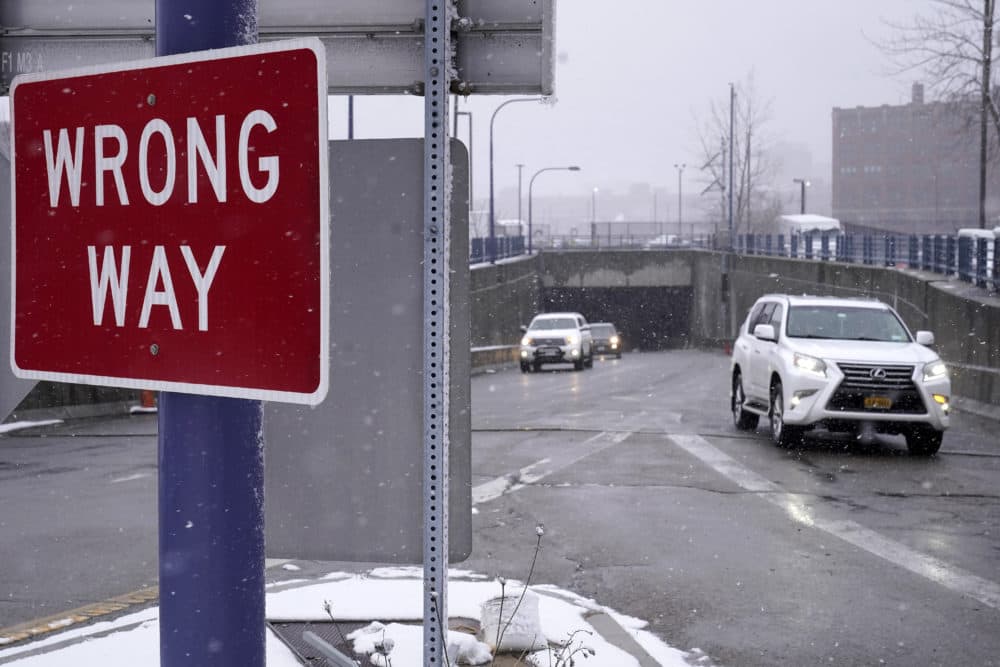Advertisement
Piloted technology on Mass. highways appear effective at curbing deadly wrong-way crashes, officials say

A $2.6 million pilot program in Massachusetts seeks to discourage drivers who are heading in the wrong direction on highways, a mistake that has resulted in 30 fatalities in the state since 2014.
Under the pilot, wrong-way vehicle detection systems have been installed at highway ramps. When the system detects a car entering a ramp in the wrong direction it sets off flashing lights, signs and, at some locations, audible alarms to alert the driver.
“It gives you an opportunity to hit the brakes, realize you’ve gone in the wrong direction and turn around," said Massachusetts Highway Administrator Jonathan Gulliver.
If the driver continues despite the warning system, state police receive a notice of a possible wrong-way driver. The highway operations center is also notified so they can immediately activate message boards on the roadway to let other motorists know someone might be driving in the wrong direction toward them.
The Massachusetts system, which is funded through a mix of state and federal dollars, has so far been set up at 10 locations with another six next in line as part of the pilot program.
Initially, the pilot program was intended to be a multi-year effort, but the system has proven so successful officials said the state will work to expand it quickly, Gulliver said.
Since the first warning systems were set up in November, the state has recorded 22 alarms, resulting in several drivers self-correcting, according to officials.
Among the challenges facing Massachusetts is that it is a densely populated state with older road systems that can sometimes be confusing to local drivers and visitors. Gulliver said that over the years, the state has taken steps to reduce that confusion — and the wrong-way program is meant to help.
What leads to wrong-way crashes
Older drivers, younger inexperienced drivers and impaired drivers — including those under the influence of alcohol — tend to be more at risk of initiating wrong-way crashes, according to researchers.
Most wrong-way crashes that result in a fatality occur at night, when it’s harder to see signs. A disproportionate number also happen on the weekend, which could coincide with increased alcohol consumption.
“When wrong-way driver crashes happen they generally lead to fatalities. They are some of the most deadly crashes we have, especially when they’re on the interstates involving high speed,” Gulliver said.
Similar efforts elsewhere in the U.S.
But the problem is not isolated in Massachusetts. Each year in the United States, wrong-way driving results in 400 to 500 deaths according to federal highway administrators.
At least a handful of states have launched programs to address these types of crashes. Gulliver said the Massachusetts pilot program, in part, draws on similar initiatives in other states, including Texas and Rhode Island.
Nearby Connecticut is among the latest to join the effort to curb the frequency of deadly wrong-way highway collisions by adopting crash prevention technologies.
Connecticut last year touted a $20 million program intended to install cameras on wrong-way signs across the state that would trigger flashing lights when a wrong-way driver is detected.
Several bills have been filed to expand that program.
Last month, the death of Connecticut state Rep. Quentin Williams threw a fresh spotlight on the problem. As he was driving home from the governor's inauguration ball, he was struck head-on by a driver who had entered the highway using a ramp going in the wrong direction, killing both Williams and the driver.
“He was the life of every party. He had an infectious happiness about him. He knew everybody and if he didn’t, he would find a way to know them,” said state Sen. Matthew Lesser, a fellow Democrat who described Williams as one of his closest friends.
In Connecticut, these types of crashes led to nearly two dozen deaths in 2022 — a dramatic spike from earlier years.
“It’s one thing to know that in the abstract, it’s another to have a close friend killed,” Lesser said of the sharp increase in accidents. “It can’t but light a fire under my colleagues to explore policy solutions.”